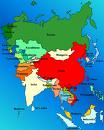ASEAN summit breaks up amid feuding over South China Sea

The Association of South East Asian Nations (ASEAN) ministerial summit broke up yesterday in acrimony after failing to reach agreement over worsening maritime disputes with China in the South China Sea. Without a consensus, no joint communiqué was released for the first time in the organisation’s 45-year history.
The diplomatic impasse is the product of the Obama administration’s aggressive “pivot” to Asia over the past three years, aimed at undercutting China’s influence throughout the region. Encouraged by the US government, the Philippines and Vietnam have taken a more assertive stance over their claims in the South China Sea, leading to heated disputes with China.
The US has put Beijing on the back foot by pushing ASEAN to adopt a common Code of Conduct as the basis for discussions with China over the maritime disputes. This multilateral approach, aimed at strengthening the position of the US and its allies, cuts directly across previous efforts by China to resolve differences with South East Asian countries on a bilateral basis.
At this week’s summit in the Cambodian capital of Phnom Penh, the Philippines provocatively pressed for the final communiqué to include a reference to the country’s two-month standoff with China over the disputed Scarborough Shoal. In a blunt statement issued on Thursday, Chinese Foreign Minister Yang Jiechi declared there was “no dispute” about China’s sovereignty over the reef. “China hopes the Philippine side faces the facts squarely and stops creating trouble,” he said.
Efforts to paper over the disagreements within ASEAN failed when Cambodia rejected a compromise wording of the final statement. Cambodia, which currently holds ASEAN’s rotating chairmanship, is closely aligned with China. While not an ASEAN member, China belongs to the associated East Asian Summit and ASEAN Regional Forum.
The failure to reach agreement sparked bitter recriminations between the Philippines and Cambodia. The Philippine foreign ministry issued a statement “deploring” the lack of a final communiqué and blaming Cambodia for opposing any mention of the Scarborough Shoal. A Cambodian Foreign Ministry official denied that his country had come under pressure from China, declaring it an “unfair accusation”.
Philippine Foreign Secretary Albert del Rosario inflamed tensions, warning that the increasing assertion by China of sovereignty over areas of the South China Sea “poses a threat to the peace and stability of the Asia-Pacific region.” He declared: “If left unchecked, the increasing tension that is being generated in the process could further escalate into physical hostilities which no one wants.”
Indonesian Foreign Minister Marty Natalegawa expressed concern over the open divisions within ASEAN. “This is strange territory for me,” he told reporters. “It’s very, very disappointing that at this 11th hour ASEAN is not able to rally around a certain common language on the South China Sea. We have gone through so many problems in the past, but we’ve never failed to speak as one.”
A great deal is at stake in the South China Sea. The area has significant energy reserves and fisheries. It also has key sea routes from Africa, the Middle East and Europe to North East Asia, accounting for about a third of the world’s shipping. The waters are adjacent to China’s southern coast and vital Chinese naval bases.
The Obama administration intervened directly into the maritime disputes in 2010 when US Secretary of State Hillary Clinton declared at an ASEAN summit that the US had “a national interest” in ensuring “freedom of navigation” through the South China Sea. The US navy routinely patrols the area, sailing close to sensitive Chinese military installations.
At this week’s meeting, Clinton allowed the Philippines to play the most confrontational role, creating diplomatic friction. But her comments left no doubt that the US was exploiting the issue to undermine China and consolidate its own influence in the region. Clinton asserted Washington’s right to intervene by declaring that “the United States is a resident Pacific power.” She pointedly criticised “worrisome instances of economic coercion and the problematic use of military and government vessels in connection with disputes among fishermen.”
Clinton’s remarks amounted to a not-so-subtle reference to the standoff over the Scarborough Shoal, as well as the row between China and Japan over the disputed Senkaku islands in the East China Sea. That dispute erupted again this week after Japanese Prime Minister Yoshihiko Noda suggested last weekend that his government would purchase the rocky outcrops from their current private owner. Not coincidentally, Clinton was in Tokyo last Sunday for talks with Noda and his ministers.
China’s state-owned media held the US responsible for the renewed tensions over the South China Sea. An article in China Daily, entitled “US sows seeds of discord,” branded Clinton’s comments as “inappropriate and ill-intentioned”. It continued: “The US, as a force from outside the region, is not in any position to tell countries in the region how to solve their differences.” The article reiterated that ASEAN meetings were not the appropriate venue to discuss the South China Sea.
The Obama administration’s intervention at ASEAN summits is just one aspect of a broad diplomatic and strategic offensive aimed at strengthening US ties with countries throughout the region. As well as closer relations with military allies and partners such as Australia, Japan, South Korea, India and the Philippines, Washington is making moves to prise countries like Burma, Cambodia and Laos away from their alignment with Beijing.
Clinton became the first US secretary of state in more than half a century to visit Laos this week, in a significant step to strengthen relations with the regime. She held talks with the Cambodian government, holding out the possibility that the US might reach an accommodation on Phnom Penh’s demand for a write-off of more than $400 million in debt accrued under the US-backed military government of Lon Nol. Clinton also met with Burmese President Thein Sein after easing sanctions on US investment in that country.
Clinton’s diplomatic moves are backed by a US military build-up in Asia. The South China Sea and key choke points, such as the Malacca Strait, are central to US strategic planning, which aims to ensure the US navy is capable of cutting off China’s shipping routes from Africa and the Middle East in the event of a conflict. To that end, the Obama administration has secured military basing arrangements with Australia and Singapore, and is seeking a similar pact with the Philippines.
The lack of agreement at this week’s ASEAN summit is just the latest indication that the Obama administration’s strategy is recklessly inflaming regional tensions and thus the danger of military conflict.
Order directly from Global Research (click title for details)
NEW RELEASE: NOW AVAILABLE IN PAPERBACK
Towards a World War III Scenario
by Michel Chossudovsky


